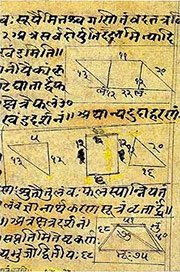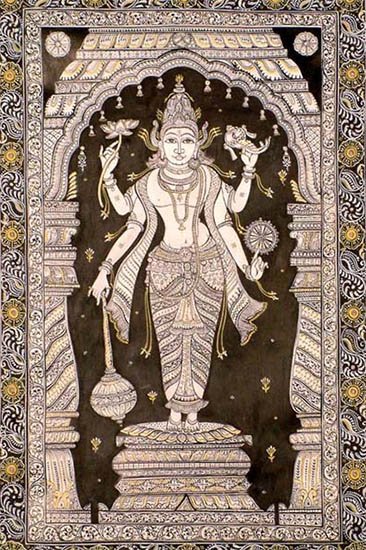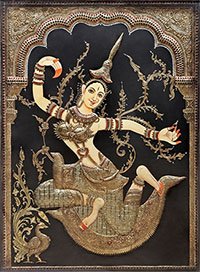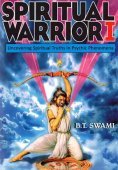Ravi, Rāvī, Rāvin, Ravin: 41 definitions
Introduction:
Ravi means something in Buddhism, Pali, Hinduism, Sanskrit, Jainism, Prakrit, the history of ancient India, Marathi, Hindi, biology, Tamil. If you want to know the exact meaning, history, etymology or English translation of this term then check out the descriptions on this page. Add your comment or reference to a book if you want to contribute to this summary article.
Images (photo gallery)
In Hinduism
Purana and Itihasa (epic history)
Source: archive.org: Puranic Encyclopedia1) Ravi (रवि).—A prince of Sauvīra. It was this prince who stood with the flag behind the chariot of Jayadratha, who had come to carry away Draupadī. He was killed by Arjuna. (Vana Parva, Chapter 221, Verse 27).
2) Ravi (रवि).—A son of Dhṛtarāṣṭra. He was killed by Bhīma in the great war. (Śalya Parva, Chapter 26, Verse 14).
Source: archive.org: Shiva Purana - English TranslationRavi (रवि) refers to the “sun”, according to the Śivapurāṇa 2.3.8.—Accordingly, Nārada said to Himavat:—“[..] In a majestic person a defect does not produce misery. It may well cause misery in a non-majestic person. Sun, fire and Gaṅgā [i.e., ravi—ravipāvakagaṃgānāṃ] may be cited as examples. Hence you give your daughter in marriage to Śiva. That will be a wise step. Lord Śiva who is the sole lord, unchanging and without any aberration is worthy of being resorted to. By performing penance, Śiva can be propitiated quickly and He will accept her undoubtedly. [...]”.
Source: Cologne Digital Sanskrit Dictionaries: The Purana Index1a) Ravi (रवि).—From av to protect—see Sūrya;1 got a place among śrāddhadevas;2 the śrāddhadeva;3 an Āditya;4 in three forms, Gayāditya, Uttarārka, and Dakṣiṇārka;5 movements of the sun, detailed; maṇḍala measurement of; rise at Samyamana, mid-day at Amarāvatī, mid-night at Suṣā, setting at Vibhāvarī; other similar calculations; the movement in a muhūrta; movement for a day and a night; movement in Dakṣiṇāyanam; chariot of, limbs of the year; the seven horses are cchandas, gāyatrī, triṣṭub, jagatī, anuṣṭub, paṅktī, bṛhatī and uṣṇik; gives a list of sages, Gandharvas, Apsaras, Nāgas, Grāmaṇi and Rākṣasas with the sun in the six seasons; these go with the sun in his own wheel;6 a marutgaṇa;7 standard of Nāga in the Tārakāmaya.8
- 1) Brahmāṇḍa-purāṇa II. 21. 4; 23. 26; 24. 35; III. 59. 37; IV. 1. 138; Vāyu-purāṇa 50. 60; Viṣṇu-purāṇa II. 8. 11-12.
- 2) Matsya-purāṇa 13. 1.
- 3) Ib. 15. 43.
- 4) Ib. 171. 56.
- 5) Vāyu-purāṇa 106. 57.
- 6) Matsya-purāṇa chh. 124-6; Vāyu-purāṇa 100. 222.
- 7) Matsya-purāṇa 171. 52.
- 8) Ib. 173. 9.
1b) Son of Svārociṣa Manu.*
- * Brahmāṇḍa-purāṇa II. 36. 19; Vāyu-purāṇa 62. 19.

The Purana (पुराण, purāṇas) refers to Sanskrit literature preserving ancient India’s vast cultural history, including historical legends, religious ceremonies, various arts and sciences. The eighteen mahapuranas total over 400,000 shlokas (metrical couplets) and date to at least several centuries BCE.
Jyotisha (astronomy and astrology)
Source: Wisdom Library: Brihat Samhita by VarahamihiraRavi (रवि) is another name for the Sun, according to the Bṛhatsaṃhitā (chapter 15) (“On the nakṣatras—‘asterisms’”), an encyclopedic Sanskrit work written by Varāhamihira mainly focusing on the science of ancient Indian astronomy astronomy (Jyotiṣa).—Accordingly, “That constellation in which the Sun [i.e., ravi] and Saturn might happen to be together or through which Mars might happen to pass or in which the retrograde motion of a planet might lie or in which a lunar or solar eclipse might take place or through which the moon might pass, will bring misery to the persons and objects it represents. If on the other hand the constellation should be free from any such affection, the same persons or objects will prosper”.
Source: Wikibooks (hi): Sanskrit Technical TermsRavi (रवि).—The Sun. Note: Ravi is a Sanskrit technical term used in ancient Indian sciences such as Astronomy, Mathematics and Geometry.

Jyotisha (ज्योतिष, jyotiṣa or jyotish) refers to ‘astronomy’ or “Vedic astrology” and represents the fifth of the six Vedangas (additional sciences to be studied along with the Vedas). Jyotisha concerns itself with the study and prediction of the movements of celestial bodies, in order to calculate the auspicious time for rituals and ceremonies.
Shaivism (Shaiva philosophy)
Source: Shodhganga: Iconographical representations of ŚivaRavi (रवि) is the name of a deity who received the Aṃśumadāgama from Ugra who in turn, received it from Ambu (Aṃśu) through the mahānsambandha relation, according to the pratisaṃhitā theory of Āgama origin and relationship (sambandha). The aṃśumat-āgama, being part of the ten Śivabhedāgamas, refers to one of the twenty-eight Siddhāntāgamas: a classification of the Śaiva division of Śaivāgamas. The Śaivāgamas represent the wisdom that has come down from lord Śiva, received by Pārvatī and accepted by Viṣṇu.
Ravi obtained the Aṃśumadāgama from Ugra who in turn obtained it from Ambu (Aṃśu) who in turn obtained it from Sadāśiva through parasambandha. Ravi then, through divya-sambandha transmitted it to the Devas who, through divyādivya-sambandha, transmitted it to the Ṛṣis who finally, through adivya-sambandha, revealed the Aṃśumadāgama to human beings (Manuṣya). (also see Anantaśambhu’s commentary on the Siddhāntasārāvali of Trilocanaśivācārya)

Shaiva (शैव, śaiva) or Shaivism (śaivism) represents a tradition of Hinduism worshiping Shiva as the supreme being. Closely related to Shaktism, Shaiva literature includes a range of scriptures, including Tantras, while the root of this tradition may be traced back to the ancient Vedas.
Ayurveda (science of life)
Kalpa (Formulas, Drug prescriptions and other Medicinal preparations)
Source: Shodhganga: Edition translation and critical study of yogasarasamgrahaRavi (रवि) is another name for “Arka” and is dealt with in the 15th-century Yogasārasaṅgraha (Yogasara-saṅgraha) by Vāsudeva: an unpublished Keralite work representing an Ayurvedic compendium of medicinal recipes. The Yogasārasaṃgraha [mentioning ravi] deals with entire recipes in the route of administration, and thus deals with the knowledge of pharmacy (bhaiṣajya-kalpanā) which is a branch of pharmacology (dravyaguṇa).
Unclassified Ayurveda definitions
Source: archive.org: Vagbhata’s Ashtanga Hridaya Samhita (first 5 chapters)Ravi (रवि) or is the author of the Vyākhyāsāra: a commentary on the Aṣṭāṅgahṛdayasaṃhitā: one of the three great works of Vāgbhaṭa.—The Aṣṭāṅgahṛdayasaṃhitā consists only of verses. The eight-fold division is observed in the Aṣṭāṅgahṛdayasaṃhitā too, though not as strictly as in the Aṣṭāṅgasaṃgraha. Numerous commentaries on the Aṣṭāṅgahṛdayasaṃhitā [viz., Ravi’s Vyākhyāsāra], many of them unedited so far, can be traced in manuscripts, catalogues, publishers’ lists, etc.

Āyurveda (आयुर्वेद, ayurveda) is a branch of Indian science dealing with medicine, herbalism, taxology, anatomy, surgery, alchemy and related topics. Traditional practice of Āyurveda in ancient India dates back to at least the first millenium BC. Literature is commonly written in Sanskrit using various poetic metres.
Shaktism (Shakta philosophy)
Source: Google Books: Manthanabhairavatantram1) Ravi (रवि) refers to the “sun”, according to the Devīpañcaśataka, an important source of the Kālīkrama that developed in Kashmir after the Kālī Mata of the Jayadrathayāmala.—Accordingly, “The permutation (of the Transmental) is said to be the Light that precedes the mistress of the Wheel of Rays [i.e., puñjacakra-īśī] (of divine consciousness). [...] (That light) is not the moon, (or) the light of the stars; it is not the light of the rays of (the sun), the lord of the sky, nor is it the brilliance of lightning—nor is it like the beautiful sun (of energy). That Light (bhāsā) is seen in the belly (of consciousness) with the eye of knowledge, that is, in the eye on the path of opening. She is not seen otherwise. All (things) shine due to her: Fire, Moon, Sun and stars. As the division of Sun and Moon [i.e., ravi-soma-vibhāga], she bestows the plane of oneness. Thus she is the aggregate (kula) of rays and, ferocious, she is the Supreme One (Parā) who has reached the final end of Kula and devours duality with the Yoga of the Fire of (Universal) Destruction.”.—(Cf. Puñjacakra).
2) Rāvin (राविन्) (Cf. Rāviṇī) refers to “one who makes a sound”, according to the Jayadrathayāmala verse 3.11.40.—Accordingly, “The Kālī of menses who resounds in the abode of the triangle with three parts which is (always) in menses in the three times is Nityaklinnā who makes the beautiful sound [i.e., surāviṇī] (of consciousness)”.

Shakta (शाक्त, śākta) or Shaktism (śāktism) represents a tradition of Hinduism where the Goddess (Devi) is revered and worshipped. Shakta literature includes a range of scriptures, including various Agamas and Tantras, although its roots may be traced back to the Vedas.
Kavya (poetry)
Source: Brill: Śaivism and the Tantric Traditions (kavya)Ravi (रवि) refers to the “sun”, according to Kālidāsa’s Raghuvaṃśa verse 9.78.—Accordingly: “Therefore, although the sun (ravi) may fall to earth, or Himālaya lose its fixity, I’ll not return home like a common man, whose senses yearn for sensual things, and who has not perceived the truth”.

Kavya (काव्य, kavya) refers to Sanskrit poetry, a popular ancient Indian tradition of literature. There have been many Sanskrit poets over the ages, hailing from ancient India and beyond. This topic includes mahakavya, or ‘epic poetry’ and natya, or ‘dramatic poetry’.
Ganitashastra (Mathematics and Algebra)
Source: archive.org: Hindu MathematicsRavi (रवि) represents the number 12 (twelve) in the “word-numeral system” (bhūtasaṃkhyā), which was used in Sanskrit texts dealing with astronomy, mathematics, metrics, as well as in the dates of inscriptions and manuscripts in ancient Indian literature.—A system of expressing numbers by means of words arranged as in the place-value notation was developed and perfected in India in the early centuries of the Christian era. In this system the numerals [e.g., 12—ravi] are expressed by names of things, beings or concepts, which, naturally or in accordance with the teaching of the Śāstras, connote numbers.

Ganitashastra (शिल्पशास्त्र, gaṇitaśāstra) refers to the ancient Indian science of mathematics, algebra, number theory, arithmetic, etc. Closely allied with astronomy, both were commonly taught and studied in universities, even since the 1st millennium BCE. Ganita-shastra also includes ritualistic math-books such as the Shulba-sutras.
Shilpashastra (iconography)
Source: Shodhganga: Elements of Art and Architecture in the Trtiyakhanda of the Visnudharmottarapurana (shilpa)Ravi refers to one of the names of the Sun-God (Āditya), whose iconography is described in the Viṣṇudharmottarapurāṇa, an ancient Sanskrit text which (being encyclopedic in nature) deals with a variety of cultural topics such as arts, architecture, music, grammar and astronomy.—According to the Viṣṇudharmottarapurāṇa the image of Sun god should be adorned with bright coloured attire. Sunbeams, reins should be placed in the left and a lotus should be placed in the right hand of the idol of the Sun (Ravi).

Shilpashastra (शिल्पशास्त्र, śilpaśāstra) represents the ancient Indian science (shastra) of creative arts (shilpa) such as sculpture, iconography and painting. Closely related to Vastushastra (architecture), they often share the same literature.
Sports, Arts and Entertainment (wordly enjoyments)
Source: archive.org: Syainika Sastra of Rudradeva with English Translation (art)Rāvin (राविन्) (Cf. Rāviṇī) refers to “one who scream”, according to the Śyainika-śāstra: a Sanskrit treatise dealing with the divisions and benefits of Hunting and Hawking, written by Rājā Rudradeva (or Candradeva) in possibly the 13th century.—Accordingly, “Hunting by packs of dogs is that in which dogs are let loose at hares and other animals in arid tracts. [...] The hares scream loudly (ghurghura-uddāma-rāviṇī) and the dogs pursue them; and in a short time there is a great fight tooth and nail. This produces a feeling of the terrible. [...]”.

This section covers the skills and profiencies of the Kalas (“performing arts”) and Shastras (“sciences”) involving ancient Indian traditions of sports, games, arts, entertainment, love-making and other means of wordly enjoyments. Traditionally these topics were dealt with in Sanskrit treatises explaing the philosophy and the justification of enjoying the pleasures of the senses.
In Buddhism
Tibetan Buddhism (Vajrayana or tantric Buddhism)
Source: academia.edu: The Structure and Meanings of the Heruka MaṇḍalaRavi (रवि) refers to one of the eight direction-guardians (dikpāla) of the Jñānacakra, according to the 10th century Ḍākārṇava chapter 15. Accordingly, the jñānacakra refers to one of the three divisions of the saṃbhoga-puṭa (‘enjoyment layer’), situated in the Herukamaṇḍala. Ravi is associated with the charnel ground (śmaśāna) named Bālamṛtyu and with the tree (vṛkṣa) named Candana.

Tibetan Buddhism includes schools such as Nyingma, Kadampa, Kagyu and Gelug. Their primary canon of literature is divided in two broad categories: The Kangyur, which consists of Buddha’s words, and the Tengyur, which includes commentaries from various sources. Esotericism and tantra techniques (vajrayāna) are collected indepently.
In Jainism
General definition (in Jainism)
Source: archive.org: Een Kritische Studie Van Svayambhūdeva’s PaümacariuRavi (रवि) participated in the war between Rāma and Rāvaṇa, on the side of the latter, as mentioned in Svayambhūdeva’s Paumacariu (Padmacarita, Paumacariya or Rāmāyaṇapurāṇa) chapter 57ff. Svayambhū or Svayambhūdeva (8th or 9th century) was a Jain householder who probably lived in Karnataka. His work recounts the popular Rāma story as known from the older work Rāmāyaṇa (written by Vālmīki). Various chapters [mentioning Ravi] are dedicated to the humongous battle whose armies (known as akṣauhiṇīs) consisted of millions of soldiers, horses and elephants, etc.

Jainism is an Indian religion of Dharma whose doctrine revolves around harmlessness (ahimsa) towards every living being. The two major branches (Digambara and Svetambara) of Jainism stimulate self-control (or, shramana, ‘self-reliance’) and spiritual development through a path of peace for the soul to progess to the ultimate goal.
India history and geography
Source: What is India: Epigraphia Indica volume XXXI (1955-56)Ravī is one of the Brāhmaṇa donees mentioned in the “Asankhali plates of Narasiṃha II” (1302 A.D.). When a grant was made to a large number of Brāhmaṇas, the chief amongst the donees seems to have been called Pānīyagrāhin especially. In the present record, though all the donees (e.g., Ravī) are referred to as Pāṇigrāhi-mahājana, their list is headed by a Brāhmaṇa with Pāṇigrahī as his surname.
These copper plates (mentioning Ravī) were discovered from the house of a Santal inhabitant of Pargana Asankhali in the Mayurbhanj State (Orissa). It was made when king Vīra-Narasiṃhadeva was staying at the Bhairavapura-kaṭaka (city, camp or residence).
Source: Cologne Digital Sanskrit Dictionaries: Indian Epigraphical GlossaryRavi.—(IE 7-1-2), ‘twelve’. Note: ravi is defined in the “Indian epigraphical glossary” as it can be found on ancient inscriptions commonly written in Sanskrit, Prakrit or Dravidian languages.

The history of India traces the identification of countries, villages, towns and other regions of India, as well as mythology, zoology, royal dynasties, rulers, tribes, local festivities and traditions and regional languages. Ancient India enjoyed religious freedom and encourages the path of Dharma, a concept common to Buddhism, Hinduism, and Jainism.
Biology (plants and animals)
Source: Google Books: CRC World Dictionary (Regional names)1) Ravi in India is the name of a plant defined with Calotropis gigantea in various botanical sources. This page contains potential references in Ayurveda, modern medicine, and other folk traditions or local practices It has the synonym Streptocaulon cochinchinense G. Don (among others).
2) Ravi is also identified with Calotropis procera It has the synonym Apocynum syriacum S.G. Gmel. (etc.).
3) Ravi is also identified with Ficus arnottiana It has the synonym Urostigma arnottianum Miq. (etc.).
4) Ravi is also identified with Ficus religiosa It has the synonym Urostigma religiosum (Linnaeus) Gasparrini (etc.).
Example references for further research on medicinal uses or toxicity (see latin names for full list):
· Flora Cochinchinensis (1790)
· Hortus Kewensis (1789)
· Notes from the Royal Botanic Garden, Edinburgh (1980)
· Nepal Med. Coll. J. (2006)
· Proceedings of the Indian Science Congress Association (1988)
· Species Plantarum
If you are looking for specific details regarding Ravi, for example side effects, chemical composition, health benefits, extract dosage, diet and recipes, pregnancy safety, have a look at these references.

This sections includes definitions from the five kingdoms of living things: Animals, Plants, Fungi, Protists and Monera. It will include both the official binomial nomenclature (scientific names usually in Latin) as well as regional spellings and variants.
Languages of India and abroad
Pali-English dictionary
Source: BuddhaSasana: Concise Pali-English Dictionaryravi : (aor. of ravati) made a noise; cried. || ravi (m.) the sun.
Source: Sutta: The Pali Text Society's Pali-English DictionaryRavi, (cp. Sk. ravi) the sun J. II, 375 (taruṇa°-vaṇṇaratha).

Pali is the language of the Tipiṭaka, which is the sacred canon of Theravāda Buddhism and contains much of the Buddha’s speech. Closeley related to Sanskrit, both languages are used interchangeably between religions.
Marathi-English dictionary
Source: DDSA: The Molesworth Marathi and English Dictionaryravi (रवि).—m (S) The sun. 2 A tree (commonly ruī), Gigantic swallowwort. 3 The right canal for the vital air. See under iḍā.
--- OR ---
ravī (रवी).—f A churning staff. 2 In architecture. An arrangement with beams and stanchions upon the walls of a house; in order to enlarge the space originally intended between their summits and the roof, and thus to afford room for a sort of loft, v dē. 3 pl (ravyā) The sticks which are inserted into the muṇḍhā or mouth of a pakhāla to keep it expanded during the filling.
Source: DDSA: The Aryabhusan school dictionary, Marathi-Englishravi (रवि).—m The sun. ravivāra-vāsara m Sunday.
--- OR ---
ravī (रवी).—f A churning-staff. ravīdōra m The churn-rope.
Marathi is an Indo-European language having over 70 million native speakers people in (predominantly) Maharashtra India. Marathi, like many other Indo-Aryan languages, evolved from early forms of Prakrit, which itself is a subset of Sanskrit, one of the most ancient languages of the world.
Sanskrit dictionary
Source: DDSA: The practical Sanskrit-English dictionaryRavi (रवि).—[cf. Uṇādi-sūtra 4.15]
1) The sun; सहस्रगुणमुत्स्रष्टुमादत्ते हि रसं रविः (sahasraguṇamutsraṣṭumādatte hi rasaṃ raviḥ) R.1.18.
2) A mountain.
3) The Arka plant.
4) The number 'twelve'.
Derivable forms: raviḥ (रविः).
Source: Cologne Digital Sanskrit Dictionaries: Shabda-Sagara Sanskrit-English DictionaryRavi (रवि).—m.
(-viḥ) 1. The sun. 2. The right canal for the passage of the vital air. E. ru to sound, passive form, to be praised or glorified, Unadi aff. in .
Source: Cologne Digital Sanskrit Dictionaries: Benfey Sanskrit-English DictionaryRavi (रवि).—m. 1. The sun, [Pañcatantra] 189, 23; [Mānavadharmaśāstra] 1, 23. 2. A proper name, [Draupadīpramātha] 2, 21.
Source: Cologne Digital Sanskrit Dictionaries: Cappeller Sanskrit-English DictionaryRavi (रवि).—[masculine] the sun.
Source: Cologne Digital Sanskrit Dictionaries: Cappeller Sanskrit-English DictionaryRāvin (राविन्).—[adjective] roaring, sounding, crying like (—°).
Source: Cologne Digital Sanskrit Dictionaries: Aufrecht Catalogus Catalogorum1) Ravi (रवि) as mentioned in Aufrecht’s Catalogus Catalogorum:—Horāprakāśa.
2) Ravi (रवि):—son of Ratnapāṇi, grandson of Acyuta, who was minister of Śivasiṃha, king of Mithilā: Kāvyaprakāśaṭīkā Madhumatī.
Source: Cologne Digital Sanskrit Dictionaries: Monier-Williams Sanskrit-English Dictionary1) Ravi (रवि):—m. ([according to] to [Uṇādi-sūtra iv, 138 [Scholiast or Commentator]] [from] √1. ru) a [particular] form of the sun (sometimes regarded as one of the 12 Ādityas; hence ravi is also a Name of the number ‘twelve’), [Varāha-mihira; Harivaṃśa] etc.
2) the sun (in general) or the sun-god, [Manu-smṛti; Mahābhārata] etc.
3) = ravidina, Sunday, [Inscriptions]
4) Calotropis Gigantea, [cf. Lexicographers, esp. such as amarasiṃha, halāyudha, hemacandra, etc.]
5) a mountain, [cf. Lexicographers, esp. such as amarasiṃha, halāyudha, hemacandra, etc.]
6) Name of a Sauvīraka, [Mahābhārata]
7) of a son of Dhṛta-rāṣṭra, [ib.]
8) of the author of a [commentator or commentary] on the Kāvya-prakāśa, [Catalogue(s)]
9) of the author of the Horāprakāśa, [ib.]
10) the right canal for the passage of the vital air (?), [Horace H. Wilson]
Source: Cologne Digital Sanskrit Dictionaries: Monier-Williams Sanskrit-English DictionaryRāvin (राविन्):—[from rāva] mf(iṇī)n. screaming, crying, roaring, bellowing, [Mahābhārata; Rāmāyaṇa; Varāha-mihira’s Bṛhat-saṃhitā]
Source: Cologne Digital Sanskrit Dictionaries: Yates Sanskrit-English DictionaryRavi (रवि):—(viḥ) 2. m. The sun.
Source: DDSA: Paia-sadda-mahannavo; a comprehensive Prakrit Hindi dictionary (S)Ravi (रवि) in the Sanskrit language is related to the Prakrit words: Rai, Ravi.
Source: DDSA: Paia-sadda-mahannavo; a comprehensive Prakrit Hindi dictionary (S)Ravin (रविन्) in the Sanskrit language is related to the Prakrit word: Ravi.
[Sanskrit to German]
Sanskrit, also spelled संस्कृतम् (saṃskṛtam), is an ancient language of India commonly seen as the grandmother of the Indo-European language family (even English!). Closely allied with Prakrit and Pali, Sanskrit is more exhaustive in both grammar and terms and has the most extensive collection of literature in the world, greatly surpassing its sister-languages Greek and Latin.
Hindi dictionary
Source: DDSA: A practical Hindi-English dictionaryRavi (रवि):—(nm) the sun; ~[kara] a sunray; ~[dina] sunday; ~[maṃḍala] the halo round the sun; ~[vāra/vāsara] sunday.
...
Prakrit-English dictionary
Source: DDSA: Paia-sadda-mahannavo; a comprehensive Prakrit Hindi dictionary1) Ravi (रवि) in the Prakrit language is related to the Sanskrit word: Ravin.
2) Ravi (रवि) also relates to the Sanskrit word: Ravi.
Prakrit is an ancient language closely associated with both Pali and Sanskrit. Jain literature is often composed in this language or sub-dialects, such as the Agamas and their commentaries which are written in Ardhamagadhi and Maharashtri Prakrit. The earliest extant texts can be dated to as early as the 4th century BCE although core portions might be older.
Kannada-English dictionary
Source: Alar: Kannada-English corpusRavi (ರವಿ):—
1) [noun] the sun.
2) [noun] a mountain.
3) [noun] the plant Calotropis gigantea ( = C. procera) of Asciepiadaceae family.
4) [noun] (math.) a symbol for the number twelve.
5) [noun] (pros.) a metrical foot consisting of one short syllablic instant followed by one long and another short one (u-u); amphibrachys.
--- OR ---
Rāvi (ರಾವಿ):—[noun] the holy tree Ficus religiosa of Moraceae family; the peepul tree.
Kannada is a Dravidian language (as opposed to the Indo-European language family) mainly spoken in the southwestern region of India.
See also (Relevant definitions)
Starts with (+121): Ravi-bana, Ravi-candra, Ravia, Ravia, Ravibhagana, Ravibhakta, Ravibheda, Ravibimba, Ravicakra, Ravicakrakshepakadhruvanka, Ravicakrakshepakadhruvankah, Ravicamdrike, Ravicandra, Ravichakra, Ravichettu, Ravicu, Ravidasa, Ravidasa kavi, Ravidatta, Ravidattam.
Ends with (+150): Abravi, Amganavaravi, Anandabhairavi, Anantapairavi, Annapurnabhairavi, Annuravi, Aparavi, Aravi, Areravi, Arikkiravi, Arukiravi, Atakkiravi, Babhravi, Bahiravi, Balaravi, Bhairavi, Bharavi, Bhootala bhairavi, Bhut-bhiravi, Bhutalabhairavi.
Full-text (+222): Kruraravin, Ravivara, Ravisamjnaka, Raviloha, Ravipriya, Ravikanta, Samravin, Brihadravin, Ravivasara, Ravimarga, Ravinetra, Samravina, Ravisamkranti, Ravinandana, Raviputra, Ravisunu, Iravati, Ravakhamba, Areravaki, Ravisamkrantinirnaya.
Relevant text
Search found 77 books and stories containing Ravi, Rāvī, Rāvin, Ravin, Ravī, Rāvi; (plurals include: Ravis, Rāvīs, Rāvins, Ravins, Ravīs, Rāvis). You can also click to the full overview containing English textual excerpts. Below are direct links for the most relevant articles:
Sahitya-kaumudi by Baladeva Vidyabhushana (by Gaurapada Dāsa)
Text 10.69 < [Chapter 10 - Ornaments of Meaning]
Text 11.42 < [Chapter 11 - Additional Ornaments]
Text 8.29 < [Chapter 8 - Literary Qualities]
Garga Samhita (English) (by Danavir Goswami)
Verse 4.14.17 < [Chapter 14 - The Story of the Jālandharīs]
Verse 1.5.27 < [Chapter 5 - The Lord’s Appearance]
Verse 1.12.42 < [Chapter 12 - Description of Śrī Nanda’s Festival]
Rivers in Ancient India (study) (by Archana Sarma)
10. The river Puruṣṇī or Ravi or Irāvatī and its present status < [Chapter 6 - Changing trends of the Rivers from Vedic to Purāṇic Age]
6. The river Vipāṭ (Beas) and the Śutudrī (Sutlej) and its present status < [Chapter 6 - Changing trends of the Rivers from Vedic to Purāṇic Age]
9. The river Chenāb or Asiknī and its present status < [Chapter 6 - Changing trends of the Rivers from Vedic to Purāṇic Age]
Sanskrit sources of Kerala history (by Suma Parappattoli)
3. The Laghubhaskariya-Vivarana < [Chapter 6 - Miscellaneous Sanskrit works bearing on Kerala history]
6. Samudrabandha’s commentary on the Alankarasarvasva < [Chapter 6 - Miscellaneous Sanskrit works bearing on Kerala history]
6.4. Ravi-varma Prasasti (Chandrakala-mala) < [Chapter 2 - Historical details from Mahatmyas and Prashastis]
Bhakti-rasamrta-sindhu (by Śrīla Rūpa Gosvāmī)
Verse 2.1.162 < [Part 1 - Ecstatic Excitants (vibhāva)]
Verse 3.2.9 < [Part 2 - Affection and Service (dāsya-rasa)]
Verse 2.1.326 < [Part 1 - Ecstatic Excitants (vibhāva)]
Vedic influence on the Sun-worship in the Puranas (by Goswami Mitali)
Part 8 - Mode of Worship < [Chapter 4 - Vedic Influence on the Sun-Worship in the Purāṇas]
Part 7 - The Depiction of Sūrya in the Anthropomorphic Form < [Chapter 4 - Vedic Influence on the Sun-Worship in the Purāṇas]
Sun-worship Vratas (51) Sarṣapa-saptamī < [Chapter 5 - Rituals Related to the Sun-Worship in the Purāṇas]
Related products

